
The Cornille's
Electrostatic Pendulum,
now
fully demystified...
created on
April 13, 2002 - JLN Labs -
Last update September 4, 2002
All informations in this page are published free and
are intended for private/educational purposes and not for
commercial applications
The purpose of this experiment is, firstly to
replicate the original Patrick Cornille's Electrostatic Pendulum
and secundly to indentify the real source of the
"anomalous" thrust in his device with a deep
investigation.
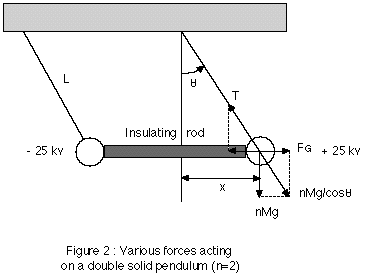
<< The experiment as
shown in Fig.2 consists of two heavy metallic balls suspended by
fine cotton wires to the ceiling of the laboratory. In order to
keep the balls at a fixed distance D, an insulating rod is used
between the balls. Therefore, the bi-filar pendulum with the two
balls make a capacitor that moves as a solid with the Earth's
velocity U = Ui where Ui is
also the ionic velocity defined with respect to the ether frame.>> from THE
ELECTROSTATIC PENDULUM EXPERIMENT WHICH PUMPS ENERGY FROM THE
ETHER -
by Patrick Cornille ( France )
These tests are conducted with full electronic HV
Bipolar Power Supply which allows accurate Voltage and Current
measurements. These tests are more accurate than the tests that I
have already conducted on September 11, 1997
with a simple Wimshurst Machine.
TEST #1
: FULL REPLICATION OF THE ORIGINAL SETUP
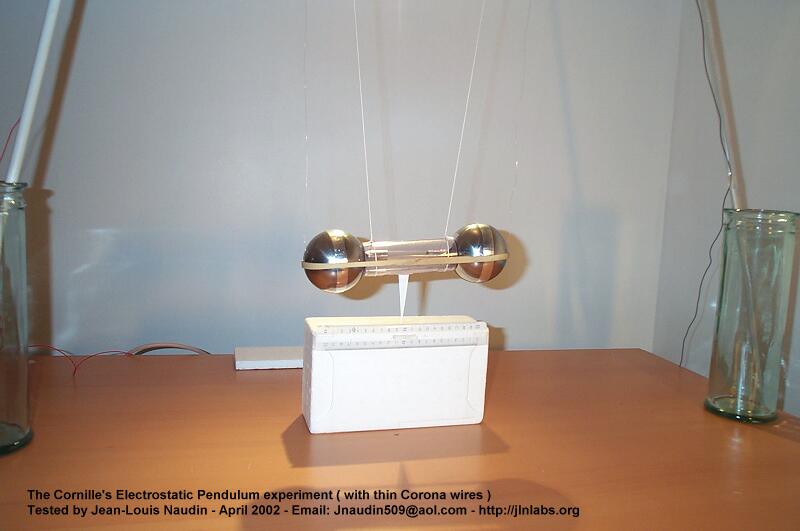
Tested apparatus
description : The Cornille's
electrostatic pendulum is composed of two steel balls ( 70mm
diam, 700g weight ) separated by a plastic cylinder (105mm
length). These 2 two steel balls are electrically connected
through a 40 KV spark gap placed between them and inside the
plastic cylinder. A rubber band maintains together the steel
balls and the plastic cylinder as shown in the photos above. The
Apparatus is suspended through two thin ropes to the lab ceiling
and two thin copper wires ( 12/100 mm diam ) are used to convey
the High Voltage. The total weight of the apparatus is 1450 g and
the total lenght of the pendulum is 1200 mm ( see the full
diagram, below ).
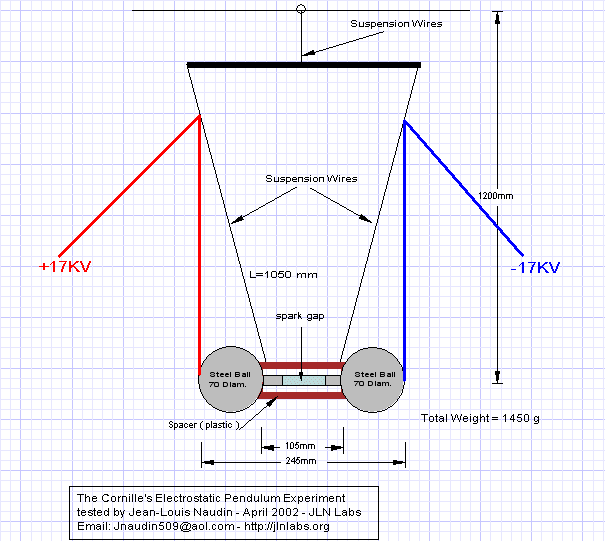

TEST #1 - RESULT
: The High Voltage ( 34 KV DC bipolar ) has been choosen so as to
be lower than the
threshold voltage of the spark gap ( 40 KV ). There is a weak
leakage current inside the spark gap which contributes to provide
a weak current flow through the two masses ( the 2 steel balls ).
When HV pulses are sent ( at a period of about 2 seconds ) the
Cornille's pendulum oscillates with an amplitude of +-10mm from
its neutral position.
Wire specification
|
Excitation Voltage
|
HV Current
|
Oscillation Period
|
Pulse Power
|
Thin copper wires (12/100 mm)
|
34 KV bipolar
|
660 uA
|
2 sec
|
23.1 Watts
|

THE TEST#1 OF THE
ELECTROSTATIC PENDULUM CONFIRMS THE ORIGINAL OBSERVATIONS DONE BY
PATRICK CORNILLE HIMSELF ON JULY 27, 1996 : When HV pulses are
sent to the electrostatic pendulum, a stimulated force sets the
device into motion.
To see the videos, the free
downloadable RealPlayer is required 
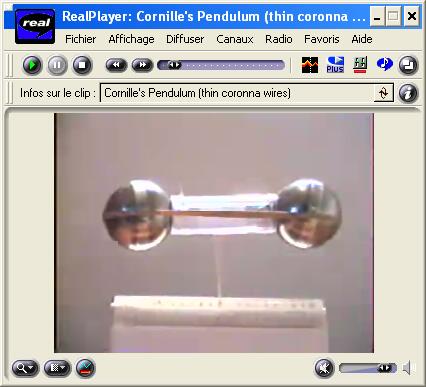
Click on the
picture to see the video of this test ( 344 kb )
TEST #2
: THE CORONA WIRES HAS BEEN REPLACED BY INSULATED WIRES
This test is similar to the previous test. Only the
thin corona wires have been replaced by full insulated wires.
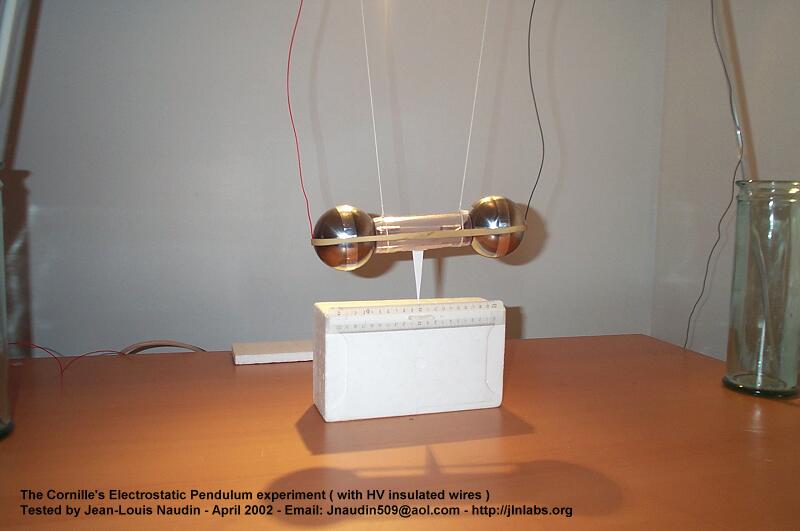
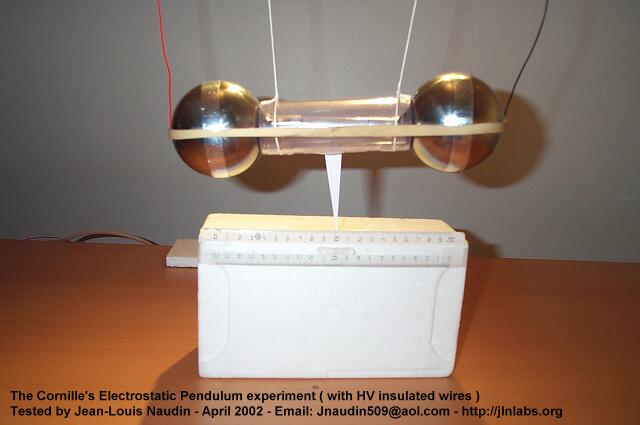
TEST #2 - RESULT
: As in the previous test, the High Voltage ( 34 KV DC bipolar )
has been choosen so as to be lower
than the threshold voltage of the spark gap ( 40 KV ). The weak
leakage current inside the spark gap contributes to provide a
weak current flow through the two masses ( the 2 steel balls ).
When HV pulses is sent ( at a period of
about 2 seconds ) the Cornille's pendulum doesn't
oscillate. There is NO
OBSERVABLE MOTION of the pendulum.
Wire specification
|
Excitation Voltage
|
HV Current
|
Oscillation Period
|
Pulse Power
|
Full Insulated wires
|
34 KV bipolar
|
510 uA
|
NA
|
17.85 Watts
|
In the TEST#2 OF
THE CORNILLE's ELECTROSTATIC PENDULUM with fully insulated wires,
NO
OSCILLATION of the device has been observed.
To see the videos, the free
downloadable RealPlayer is required 
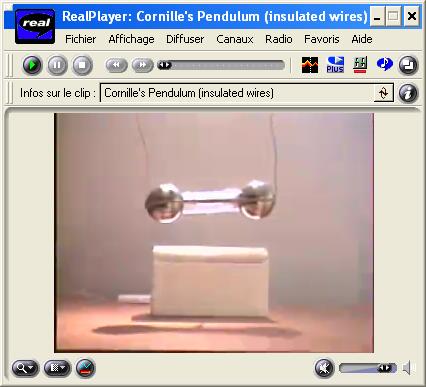
Click on the
picture to see the video of this test ( 282 kb )
TEST #3
: WITH INSULATED WIRES WITH SPARKS ( generation of pulses of
current )
In this experiment, the High Voltage has been choosen so as to get a spark
when the HV Power supply is switched on. The HV current pulse is
about 3 mA
and flows through the two masses ( the 2 steel balls ) as shown
in the photo below.
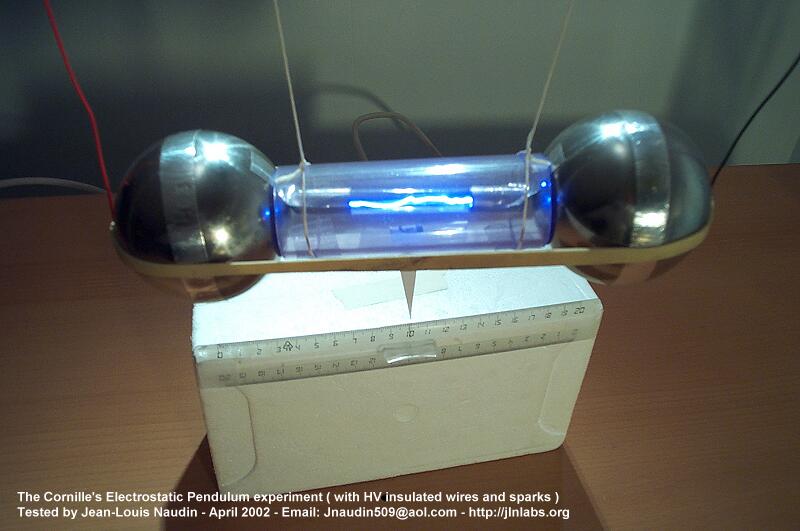
TEST #3 - RESULT
: The High Voltage ( 50 KV DC bipolar ) has been choosen so as to
be higher
than the threshold voltage of the spark gap ( 40 KV ). There is a
strong current ( 3 mA
) inside the spark gap during the pulse, this current flows
through the two masses ( the 2 steel balls ). When HV pulses are
sent ( at a period of about 2 seconds ), the Cornille's pendulum
doesn't oscillate. There is NO OBSERVABLE
MOTION of the pendulum.
Wire specification
|
Excitation Voltage
|
HV Current
|
Oscillation Period
|
Pulse Power
|
Full Insulated wires
|
50 KV bipolar
|
3 mA
|
NA
|
150 Watts
|
In the TEST#3 OF
THE CORNILLE's ELECTROSTATIC PENDULUM with fully insulated wires
and strong current pulses,
NO
OSCILLATION of the device has been observed.
To see the videos, the free
downloadable RealPlayer is required 

Click on the
picture to see the video of this test ( 262 kb )
TEST #4
: WITH CORONA WIRES INSULATED
FROM THE STEEL BALLS.
In this new test, the two electrical
connections of the thin wires on the two masses ( the steel ball
) have been fully insulated with a thick polystyren block and an
adhesive tape as shown in the photos below. In this case, there
is NO POSSIBLE CURRENT FLOW through the two masses and there is
only a leakage current in the air and in between the two thin
wires.
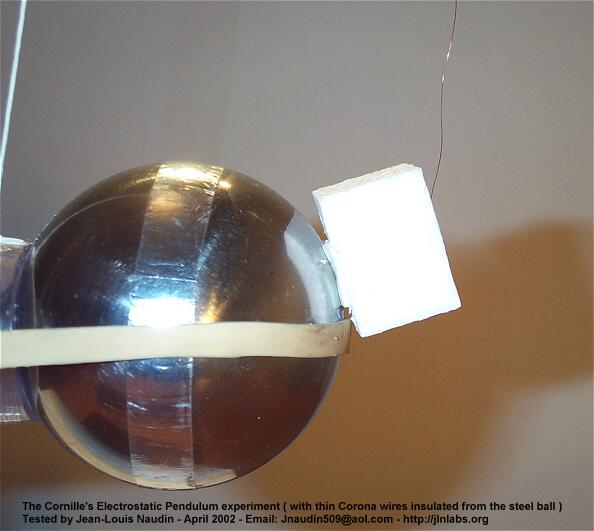
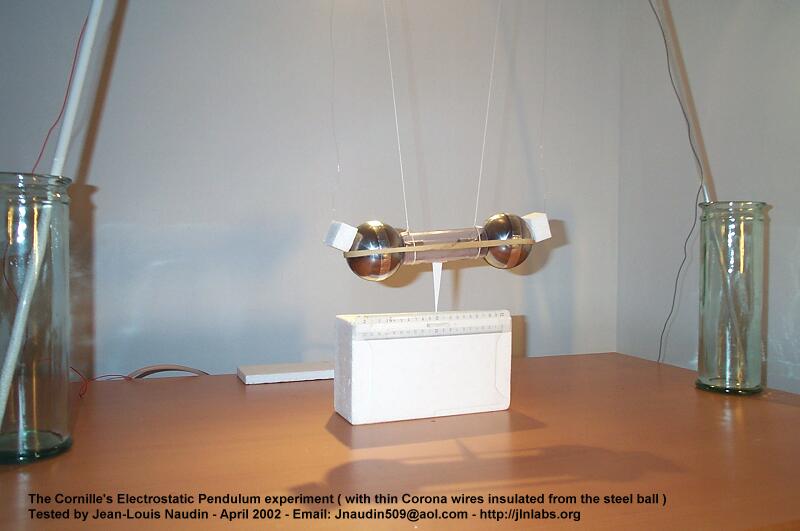
TEST #4 - RESULT
: The High Voltage ( 34 KV DC bipolar ) has exactly the same
value than in the TEST#1. When HV pulses are sent ( at a period
of about 2 seconds ) the Cornille's pendulum oscillates
at the same period and with the same amplitude than in the TEST#1.
Wire specification
|
Excitation Voltage
|
HV Current
|
Oscillation Period
|
Pulse Power
|
Thin copper wires (12/100 mm)
|
34 KV bipolar
|
570 uA
|
2 sec
|
19.95 Watts
|
In the TEST#4 OF
THE CORNILLE's ELECTROSTATIC PENDULUM
with the
thin copper wires electrically disconnected from the two masses of the
pendulum,
the
Cornille's pendulum oscillates with the same
amplitude than the TEST#1.
Additional
comment from JL Naudin :
- How a
such symmetrical configuration ( two equal (diameter and length)
thin spaced wires ) is able to generate a directional thrust ?
This can
be simply explained by the fact that the ionic mobility of
positive ions in the air, 1.32 (cm/sec)/(volt/cm), is less than
the ionic mobility of negative ions in the air, 2.51
(cm/sec)/(volt/cm). The concentration of the electric field near
the thin wire produces a corona discharge. Positive ions are
generated at the wire, the wire positively charged repels the
ions and thus the force on the wire is roughly equal to that on
the ions. The negative/positive mobility of ions ratio is about
1.9, so the force on a positive conductor is greater than on a
negative conductor, this is the cause of the generation of an
unidirectionnal thrust... The ES pendulum goes to the LEFT when
the HV is switched ON.
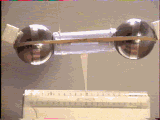
This test proves definitely
that the thrust observed in the TEST#1 is only the result
of a
simple EHD Thrust
( by the corona discharge in the air ) between the two
thin copper wires. |
To see the videos, the free
downloadable RealPlayer is required 
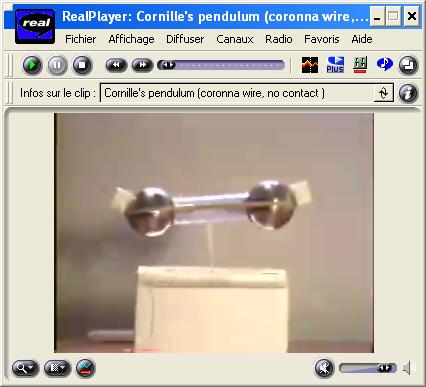
Click on the
picture to see the video of this test ( 352 kb )
CONCLUSION
OF TESTS
The Cornille's
Electrostatic Pendulum Experiment - Tested by JL Naudin on April
2002
| TEST # |
MOTION OBSERVED |
Wire
specification
|
Excitation Voltage
|
HV Current
|
Period
|
Pulse Power
|
| 1 |
YES |
Thin copper
wires (12/100 mm)
|
34 KV bipolar
|
660 uA
|
2 sec
|
23.1 Watts
|
| 2 |
NO |
Full Insulated wires
( No Spark )
|
34 KV bipolar
|
510 uA
|
NA
|
17.85 Watts
|
| 3 |
NO |
Full Insulated wires
with Spark
|
50 KV bipolar
|
3 mA
|
NA
|
150 Watts
|
| 4 |
YES |
Thin copper
wires isolated
from the masses
|
34 KV bipolar
|
570 uA
|
2 sec
|
19.95 Watts
|
| This serie of tests
about the Cornille's electrostatic pendulum has fully
demonstrated that the real source of
the thrust induced on the device and
responsible of its oscillations is only produced by a simple
EHD Effect.
This EHD Effect is generated by the corona discharge
effect in the air between the two thin copper wires which
carry the High Voltage. These EHD
forces are mechanically transmitted
to the masses and produce a common parametric excitation
of this pendulum. The shape and the structure of the
masses have no importance in this case ( conductive or
not conductive, single or two masses, spaced or not
spaced ). Additional
comments from Scott Little (
09-04-02 ): "The
reason the forces are not symmetrical is due to the fact
that the positive wire (on the left) is NEXT to a
negative wire (on the right). When the HV is on,
negative ions are created around the negative wire and,
due to their higher mobility, they move over to the
positive wire quickly, exerting only a short-duration
electrostatic attraction force for the positive wire.
But the positive ions created at the positive wire move
slowly and thus create a longer-acting electrostatic
attraction force for the negative wire. The result is a
force towards the left when the HV is on. "
|
Reference documents :
 Email : JNaudin509@aol.com
Email : JNaudin509@aol.com
Back to the Electrostatic Pendulum home
page















